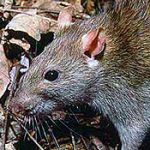The brown rat, common rat, sewer rat, Hanover rat, Norway rat, Brown Norway rat, Norwegian rat, or wharf rat (Rattus norvegicus) is one of the best known and most common rats.
It is a brown or grey rodent with a body up to 25 cm (10 in) long, and a similar tail length; the male weighs on average 350 g (12 oz) and the female 250 g (9 oz). Thought to have originated in northern China, this rodent has now spread to all continents, except Antarctica, and is the dominant rat in Europe and much of North America €” making it the most successful mammal on the planet after humans. Indeed, with rare exceptions the brown rat lives wherever humans live, particularly in urban areas.
The brown rat is a true omnivore and will consume almost anything, but cereals form a substantial part of its diet.
It is common for rats to groom each other and sleep together. As with dogs, rats create a social hierarchy, and each rat has its own place in the pack. Rats are said to establish an order of hierarchy and so one rat will be dominant over another one. Groups of rats tend to “play fight”, which can involve any combination of jumping, chasing, tumbling, and boxing. Play fighting involves rats going for each other’s necks, while serious fighting involves strikes at the others’ back ends.
Rats are known to burrow extensively, both in the wild and in captivity, if given access to a suitable substrate. Rats generally begin a new burrow adjacent to an object or structure, as this provides a sturdy “roof” for the section of the burrow nearest to the ground’s surface. Burrows usually develop to eventually include multiple levels of tunnels, as well as a secondary entrance. Older male rats will generally not burrow, while young males and females will burrow vigorously.
Burrows provide rats with shelter and food storage as well as safe, thermoregulated nest sites. Rats use their burrows to escape from perceived threats in the surrounding environment€”for example, rats will retreat to their burrows following a sudden, loud noise or while fleeing an intruder. Burrowing can therefore be described as a “pre-encounter defensive behavior”, as opposed to a “post-encounter defensive behavior”, such as flight, freezing, or avoidance of a threatening stimulus.
Similar to other rodents, brown rats may carry a number of pathogens which can result in disease, including Weil’s disease, rat bite fever, cryptosporidiosis, Viral hemorrhagic fever (VHF), Q fever and hantavirus pulmonary syndrome. This species can also serve as a reservoir for Toxoplasma gondii, the parasite that causes toxoplasmosis, though the disease usually spreads from rats to humans when domestic cats feed on infected brown rats. The parasite has a long history with the brown rat, and there are indications that the parasite has evolved to alter an infected rat’s perception to cat predation, making it more susceptible to predation and increasing the likelihood of transmission.
Surveys and specimens of brown rat populations throughout the world have shown that this species is often associated with outbreaks of trichinosis, but the extent to which the brown rat is responsible in transmitting Trichinella larvae to humans and other synanthropic animals is at least somewhat debatable. Trichinella pseudospiralis, a parasite previously not considered to be a potential pathogen in humans or domestic animals, has been found to be pathogenic in humans and carried by brown rats.

